Jiacheng Zhang
Sample-Specific Noise Injection For Diffusion-Based Adversarial Purification
Jun 06, 2025Abstract:Diffusion-based purification (DBP) methods aim to remove adversarial noise from the input sample by first injecting Gaussian noise through a forward diffusion process, and then recovering the clean example through a reverse generative process. In the above process, how much Gaussian noise is injected to the input sample is key to the success of DBP methods, which is controlled by a constant noise level $t^*$ for all samples in existing methods. In this paper, we discover that an optimal $t^*$ for each sample indeed could be different. Intuitively, the cleaner a sample is, the less the noise it should be injected, and vice versa. Motivated by this finding, we propose a new framework, called Sample-specific Score-aware Noise Injection (SSNI). Specifically, SSNI uses a pre-trained score network to estimate how much a data point deviates from the clean data distribution (i.e., score norms). Then, based on the magnitude of score norms, SSNI applies a reweighting function to adaptively adjust $t^*$ for each sample, achieving sample-specific noise injections. Empirically, incorporating our framework with existing DBP methods results in a notable improvement in both accuracy and robustness on CIFAR-10 and ImageNet-1K, highlighting the necessity to allocate distinct noise levels to different samples in DBP methods. Our code is available at: https://github.com/tmlr-group/SSNI.
NTIRE 2025 Challenge on Day and Night Raindrop Removal for Dual-Focused Images: Methods and Results
Apr 19, 2025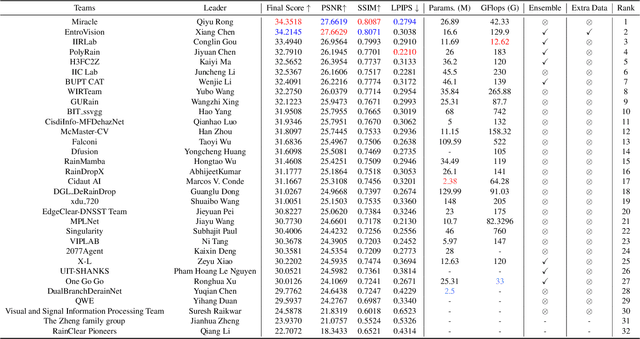
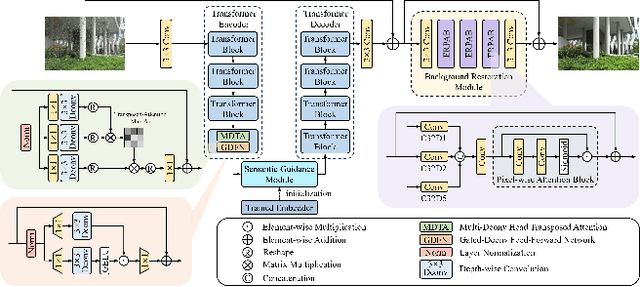
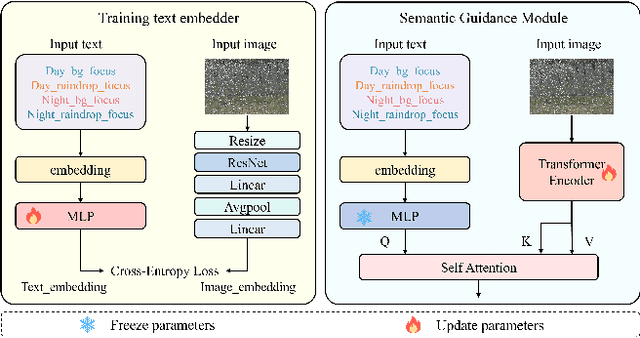
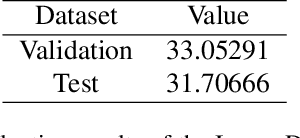
Abstract:This paper reviews the NTIRE 2025 Challenge on Day and Night Raindrop Removal for Dual-Focused Images. This challenge received a wide range of impressive solutions, which are developed and evaluated using our collected real-world Raindrop Clarity dataset. Unlike existing deraining datasets, our Raindrop Clarity dataset is more diverse and challenging in degradation types and contents, which includes day raindrop-focused, day background-focused, night raindrop-focused, and night background-focused degradations. This dataset is divided into three subsets for competition: 14,139 images for training, 240 images for validation, and 731 images for testing. The primary objective of this challenge is to establish a new and powerful benchmark for the task of removing raindrops under varying lighting and focus conditions. There are a total of 361 participants in the competition, and 32 teams submitting valid solutions and fact sheets for the final testing phase. These submissions achieved state-of-the-art (SOTA) performance on the Raindrop Clarity dataset. The project can be found at https://lixinustc.github.io/CVPR-NTIRE2025-RainDrop-Competition.github.io/.
DDAD: A Two-pronged Adversarial Defense Based on Distributional Discrepancy
Mar 04, 2025Abstract:Statistical adversarial data detection (SADD) detects whether an upcoming batch contains adversarial examples (AEs) by measuring the distributional discrepancies between clean examples (CEs) and AEs. In this paper, we reveal the potential strength of SADD-based methods by theoretically showing that minimizing distributional discrepancy can help reduce the expected loss on AEs. Nevertheless, despite these advantages, SADD-based methods have a potential limitation: they discard inputs that are detected as AEs, leading to the loss of clean information within those inputs. To address this limitation, we propose a two-pronged adversarial defense method, named Distributional-Discrepancy-based Adversarial Defense (DDAD). In the training phase, DDAD first optimizes the test power of the maximum mean discrepancy (MMD) to derive MMD-OPT, and then trains a denoiser by minimizing the MMD-OPT between CEs and AEs. In the inference phase, DDAD first leverages MMD-OPT to differentiate CEs and AEs, and then applies a two-pronged process: (1) directly feeding the detected CEs into the classifier, and (2) removing noise from the detected AEs by the distributional-discrepancy-based denoiser. Extensive experiments show that DDAD outperforms current state-of-the-art (SOTA) defense methods by notably improving clean and robust accuracy on CIFAR-10 and ImageNet-1K against adaptive white-box attacks.
Mitigating Hallucination for Large Vision Language Model by Inter-Modality Correlation Calibration Decoding
Jan 03, 2025
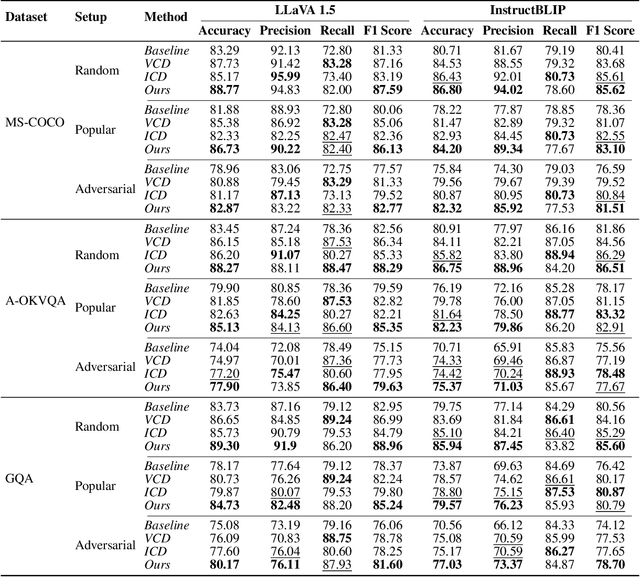
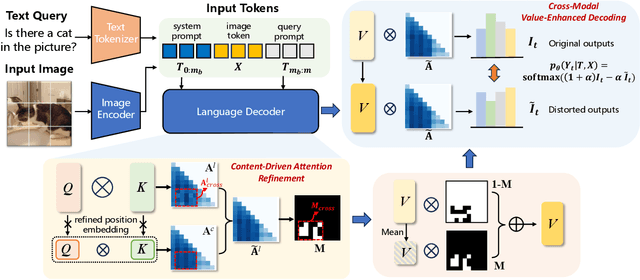

Abstract:Large vision-language models (LVLMs) have shown remarkable capabilities in visual-language understanding for downstream multi-modal tasks. Despite their success, LVLMs still suffer from generating hallucinations in complex generation tasks, leading to inconsistencies between visual inputs and generated content. To address this issue, some approaches have introduced inference-time interventions, such as contrastive decoding and attention rectification, to reduce overreliance on language priors. However, these approaches overlook hallucinations stemming from spurious inter-modality correlations. In this paper, we propose an Inter-Modality Correlation Calibration Decoding (IMCCD) method to mitigate hallucinations in LVLMs in a training-free manner. In this method, we design a Cross-Modal Value-Enhanced Decoding(CMVED) module to alleviate hallucination by a novel contrastive decoding mechanism. During the estimation of distorted distribution, CMVED masks the value vectors associated with significant cross-modal attention weights, which address both uni-modality overreliance and misleading inter-modality correlations. Additionally, a Content-Driven Attention Refinement(CDAR) module refines cross-modal attention weights, guiding LVLMs to focus on important visual content. Experimental results on diverse hallucination benchmarks validate the superiority of our method over existing state-of-the-art techniques in reducing hallucinations in LVLM text generation. Our code will be available at https://github.com/lijm48/IMCCD.
Prompt-A-Video: Prompt Your Video Diffusion Model via Preference-Aligned LLM
Dec 19, 2024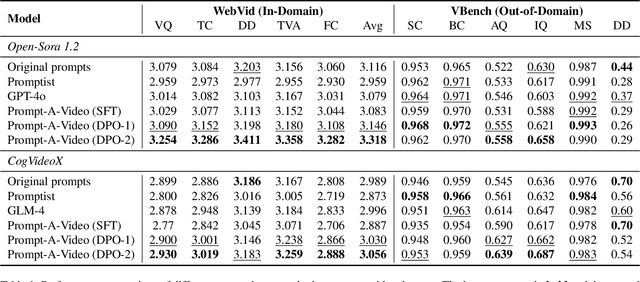

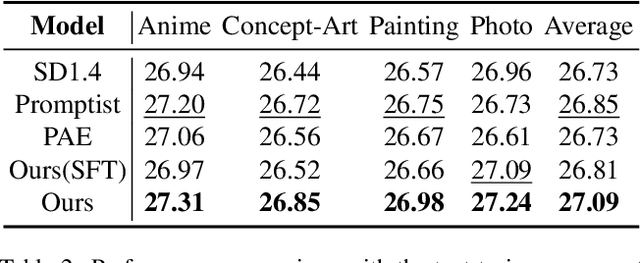

Abstract:Text-to-video models have made remarkable advancements through optimization on high-quality text-video pairs, where the textual prompts play a pivotal role in determining quality of output videos. However, achieving the desired output often entails multiple revisions and iterative inference to refine user-provided prompts. Current automatic methods for refining prompts encounter challenges such as Modality-Inconsistency, Cost-Discrepancy, and Model-Unaware when applied to text-to-video diffusion models. To address these problem, we introduce an LLM-based prompt adaptation framework, termed as Prompt-A-Video, which excels in crafting Video-Centric, Labor-Free and Preference-Aligned prompts tailored to specific video diffusion model. Our approach involves a meticulously crafted two-stage optimization and alignment system. Initially, we conduct a reward-guided prompt evolution pipeline to automatically create optimal prompts pool and leverage them for supervised fine-tuning (SFT) of the LLM. Then multi-dimensional rewards are employed to generate pairwise data for the SFT model, followed by the direct preference optimization (DPO) algorithm to further facilitate preference alignment. Through extensive experimentation and comparative analyses, we validate the effectiveness of Prompt-A-Video across diverse generation models, highlighting its potential to push the boundaries of video generation.
OnlineVPO: Align Video Diffusion Model with Online Video-Centric Preference Optimization
Dec 19, 2024



Abstract:In recent years, the field of text-to-video (T2V) generation has made significant strides. Despite this progress, there is still a gap between theoretical advancements and practical application, amplified by issues like degraded image quality and flickering artifacts. Recent advancements in enhancing the video diffusion model (VDM) through feedback learning have shown promising results. However, these methods still exhibit notable limitations, such as misaligned feedback and inferior scalability. To tackle these issues, we introduce OnlineVPO, a more efficient preference learning approach tailored specifically for video diffusion models. Our method features two novel designs, firstly, instead of directly using image-based reward feedback, we leverage the video quality assessment (VQA) model trained on synthetic data as the reward model to provide distribution and modality-aligned feedback on the video diffusion model. Additionally, we introduce an online DPO algorithm to address the off-policy optimization and scalability issue in existing video preference learning frameworks. By employing the video reward model to offer concise video feedback on the fly, OnlineVPO offers effective and efficient preference guidance. Extensive experiments on the open-source video-diffusion model demonstrate OnlineVPO as a simple yet effective and more importantly scalable preference learning algorithm for video diffusion models, offering valuable insights for future advancements in this domain.
An Efficient Occupancy World Model via Decoupled Dynamic Flow and Image-assisted Training
Dec 18, 2024



Abstract:The field of autonomous driving is experiencing a surge of interest in world models, which aim to predict potential future scenarios based on historical observations. In this paper, we introduce DFIT-OccWorld, an efficient 3D occupancy world model that leverages decoupled dynamic flow and image-assisted training strategy, substantially improving 4D scene forecasting performance. To simplify the training process, we discard the previous two-stage training strategy and innovatively reformulate the occupancy forecasting problem as a decoupled voxels warping process. Our model forecasts future dynamic voxels by warping existing observations using voxel flow, whereas static voxels are easily obtained through pose transformation. Moreover, our method incorporates an image-assisted training paradigm to enhance prediction reliability. Specifically, differentiable volume rendering is adopted to generate rendered depth maps through predicted future volumes, which are adopted in render-based photometric consistency. Experiments demonstrate the effectiveness of our approach, showcasing its state-of-the-art performance on the nuScenes and OpenScene benchmarks for 4D occupancy forecasting, end-to-end motion planning and point cloud forecasting. Concretely, it achieves state-of-the-art performances compared to existing 3D world models while incurring substantially lower computational costs.
Minimax-optimal trust-aware multi-armed bandits
Oct 04, 2024Abstract:Multi-armed bandit (MAB) algorithms have achieved significant success in sequential decision-making applications, under the premise that humans perfectly implement the recommended policy. However, existing methods often overlook the crucial factor of human trust in learning algorithms. When trust is lacking, humans may deviate from the recommended policy, leading to undesired learning performance. Motivated by this gap, we study the trust-aware MAB problem by integrating a dynamic trust model into the standard MAB framework. Specifically, it assumes that the recommended and actually implemented policy differs depending on human trust, which in turn evolves with the quality of the recommended policy. We establish the minimax regret in the presence of the trust issue and demonstrate the suboptimality of vanilla MAB algorithms such as the upper confidence bound (UCB) algorithm. To overcome this limitation, we introduce a novel two-stage trust-aware procedure that provably attains near-optimal statistical guarantees. A simulation study is conducted to illustrate the benefits of our proposed algorithm when dealing with the trust issue.
EAGLE: Towards Efficient Arbitrary Referring Visual Prompts Comprehension for Multimodal Large Language Models
Sep 26, 2024



Abstract:Recently, Multimodal Large Language Models (MLLMs) have sparked great research interests owing to their exceptional content-reasoning and instruction-following capabilities. To effectively instruct an MLLM, in addition to conventional language expressions, the practice of referring to objects by painting with brushes on images has emerged as a prevalent tool (referred to as "referring visual prompts") due to its efficacy in aligning the user's intention with specific image regions. To accommodate the most common referring visual prompts, namely points, boxes, and masks, existing approaches initially utilize specialized feature encoding modules to capture the semantics of the highlighted areas indicated by these prompts. Subsequently, these encoded region features are adapted to MLLMs through fine-tuning on a meticulously curated multimodal instruction dataset. However, such designs suffer from redundancy in architecture. Moreover, they face challenges in effectively generalizing when encountering a diverse range of arbitrary referring visual prompts in real-life scenarios. To address the above issues, we propose EAGLE, a novel MLLM that empowers comprehension of arbitrary referring visual prompts with less training efforts than existing approaches. Specifically, our EAGLE maintains the innate format of the referring visual prompts as colored patches rendered on the given image for conducting the instruction tuning. Our approach embeds referring visual prompts as spatial concepts conveying specific spatial areas comprehensible to the MLLM, with the semantic comprehension of these regions originating from the MLLM itself. Besides, we also propose a Geometry-Agnostic Learning paradigm (GAL) to further disentangle the MLLM's region-level comprehension with the specific formats of referring visual prompts. Extensive experiments are conducted to prove the effectiveness of our proposed method.
EventHallusion: Diagnosing Event Hallucinations in Video LLMs
Sep 25, 2024
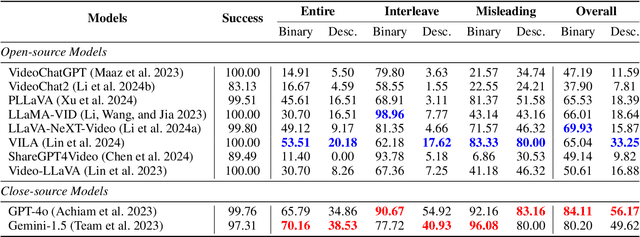
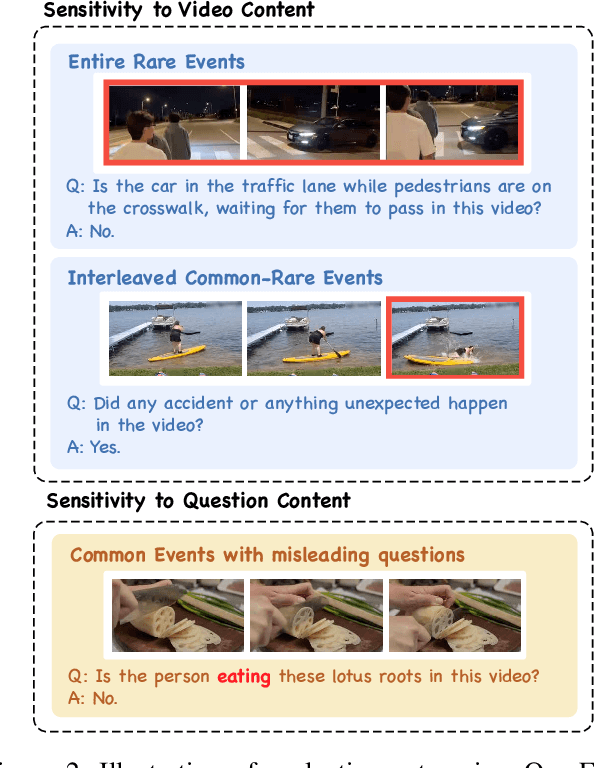

Abstract:Recently, Multimodal Large Language Models (MLLMs) have made significant progress in the video comprehension field. Despite remarkable content reasoning and instruction following capabilities they demonstrated, the hallucination problem of these VideoLLMs is less explored compared with its counterpart in the image domain. To mitigate this gap, we first propose EventHallusion, a novel benchmark that focuses on assessing the VideoLMMs' hallucination phenomenon on video event comprehension. Based on the observation that existing VideoLLMs are entangled with the priors stemming from their foundation models, our EventHallusion is curated by meticulously collecting videos and annotating questions to intentionally mislead the VideoLLMs into interpreting events based on these priors rather than accurately understanding the video content. On the other hand, we also propose a simple yet effective method, called Temporal Contrastive Decoding (TCD), to tackle the hallucination problems of VideoLLMs. The proposed TCD suppresses the model's preference toward their priors by comparing the original video with a constructed counterpart, whose temporal cues are disrupted, during the autoregressive decoding stage. Through comprehensive evaluation of eight open-source and two closed-source VideoLLMs on the proposed EventHallusion benchmark, we find that the open-source models suffer significantly from hallucination problems, whereas the closed-source models perform markedly better. By further equipping open-sourced VideoLLMs with the proposed TCD approach, evident performance improvements are achieved across most metrics in the EventHallusion benchmark. Our codes and benchmark data are available at https://github.com/Stevetich/EventHallusion.
 Add to Chrome
Add to Chrome Add to Firefox
Add to Firefox Add to Edge
Add to Edge